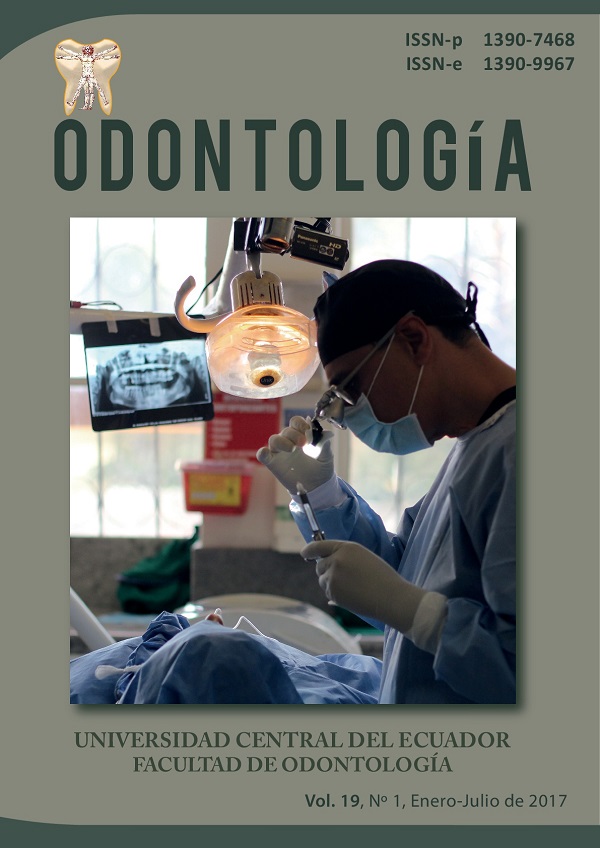Radiographic evaluation of the curvature degree and radius in the mesiobuccal canals of maxillary first molars
Keywords:
Endodontics, internal anatomy, root curvatureAbstract
Objective: Determining the curvature degree and radius and its root canals association in mesial roots of human maxillary molars of Ecuadorian population.Materials and methods: A total of 50 human maxillary first molars extracted were studied which were obtained from the Tumbaco health sub-center’s teeth bank, Pichincha Ecuador, facts as teeth with a previous root canal treatment, cavities, root resorptionand fracture were the exclusion criteria. Periapical films withparalleling technique were taken; the curvature degree was measured mesio-distally with the Schneider 1971 technique and the curvature radius was obtained with the technique described by Estrela 2008. The data collected were analyzed with the Mann Whitney’s U Test with significance level of 5%. Results:The curvature angle was determined as 10%, 58% and 32% for low, moderate and severe respectively;and the curvature radius was 64%, 34% and 2% for mild, moderate and severe respectively. Among the groups studied, there was a statistically significant difference between the moderate angle and the mild radius (p=0,02). Conclusion: The study found that the moderate curvature angle and mild radiusare the most frequent.
Downloads
References
Sadeghi S, Poryousef V. A novel approach in assessment of root canal curvature. Iranian Endodontic Journal 2009; 4(4): 131-134.
Abesi F, Ehsani M. Radiographic evaluation of maxillary anterior teeth canal curvatures in an Iranian population. Iranian Endodontic Journal 2011; 6(1): 25-28.
Willershausen B, Kasaj A, Röhrig B, Briseño Marroquin B. Radiographic Investigation of Frequency and Location of Root Canal Curvatures in Human Mandibular Anterior Incisors In Vitro. Journal of Endodontic 2008; 34: 152–156.
Estrela C, Bueno M, Sousa Neto M, Djalma J. Method for Determination of Root Curvature Radius Using Cone-Beam Computed Tomography Images. Braz Dent J 2008; 19(2): 114-118.
Tikku A, Pragya W, Shukla I. Intricate internal anatomy of teet and its clinical significance in endodontics - A review. Endodontology; 2005: 160-169.
Pecora J. Morphologic study of the maxillary molars part: external anatomy. Braz Dent J 1991; 2(1):45-50.
Zheng Q, Zhou X, Jiang Y, Sun T, Liu CH, Xue H, Huang D. Radiographic Investigation of Frequency and Degree of Canal Curvatures in Chinese Mandibular Permanent Incisors. Journal of Endodontic 2009; 35:175–178.
Schäfer E, Diez C, Hoppe W, Tepel J. Roentgenographic Investigation of Frequency and Degree of Canal Curvatures in Human Permanent Teeth. Journal of Endodontics 2002; 28(3): 211-216.
Zhu X. Evaluation of the reliability of Schneider´s and Weine´s method. Int Chin J Dent 2003; 3: 118-121.
Pruett J, Clement D, Carnes D. Cyclic fatigue testing of nickel-titanium endodontic instruments. Journal of Endodontic 1997; 23(1):77– 85.
Seidberg A. Frequency of two mesiobuccal root canals in maxillary permanent first molars. J Am Dent Assoc. 1973; 87(1):852-856.
Ki Lee J, Hyun Ha B, Ho Choi J, Heo S, Perinpanayagam H. Quantitative Three-Dimensional Analysis of Root Canal Curvature in Maxillary First Molars Using Micro-Computed Tomography. Journal of Endodontic 2006; 32: 941–945.
Günday M, Sazak H, Garip Y. A Comparative Study of Three Different Root Canal Curvature Measurement Techniques and Measuring the Canal Access Angle in Curved Canals. Journal of Endodontic 2005; 31(11):796-798.
Park P, Kim K, Perinpanayagam H, Ki Lee J, Woo Chang S, Hye Chung S, Kaufman B, Zhu Q, Safavi K, Yeon Kum Y. Three-dimensional Analysis of Root Canal Curvature and Direction of Maxillary Lateral Incisors by Using Cone-beam Computed Tomography. Journal of Endodontic 2013; 39: 1124–1129.
Willershausen B, Tekyatan H, Kasaj A, Briseño B. Roentgenographic In Vitro Investigation of Frequency and Location of Curvatures in Human Maxillary Premolars. Journal of Endodontic 2006; 32: 307–311.
Gu Y, Lu Q, Wang P, Ni L. Root Canal Morphology of Permanent Three-rooted Mandibular First Molars: Part II—Measurement of Root Canal Curvatures. Journal of Endodontic 2010; 36: 1341–1346.
Pecora. J. Internal Anatomy, Direction, and number of Roots and Size of Human Mandibular Canines. Braz Dent J 1993; 4(1): 53-57.
Campos P, Cabral C, Vasconcelos C, Lima A, Gomes M. Study of the Internal Morphology of the Mesiobuccal Root of Upper First Permanent Molar Using Cone Beam Computed Tomography. Int. J. Morphol.2011; 29(2): 617-621.
Venskutonis T, Plotino G, Juodzbalys G, Mickevicien L. The Importance of Conebeam Computed Tomography in the Management of Endodontic Problems: A Review of the Literature. JOE 2014; 40: 1895-1901
Gerhard T, Paque F, Zeller M, Willershausen B, Briseno B. Root Canal Morphology and Configuration of 118 Mandibular First Molars by Means of Micro–Computed Tomography: An Ex Vivo Study. JOE 2016: 1-5


